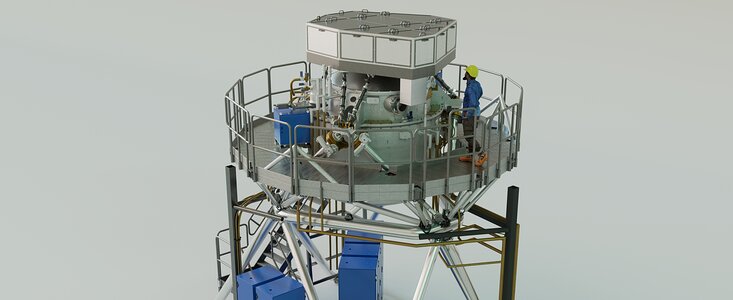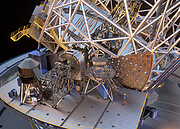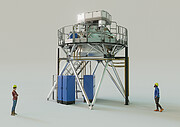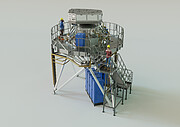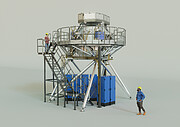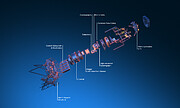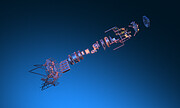Tiedote
ELT:n METIS-instrumentin suunnittelu on saatu päätökseen
14. toukokuuta 2024
Mid-infrared ELT Imager and Spectrograph, eli lyhyesti METIS, on läpäissyt lopullisen suunnittelukatsauksen, ja ESO on nyt näyttänyt vihreää valoa instrumentin kaikkien komponenttien valmistukselle. METIS on edistynyt monitoimi-instrumentti, joka tulee ESO:n tulevaan ELT-teleskooppiin (Extremely Large Telescope). Se on ensimmäinen ELT:n instrumenteista, joka on virallisesti läpäissyt lopullisen suunnittelukatsauksen, mikä on tärkeä askel METIS-konsortiolle, ELT-projektille ja instrumenttien rakennusyhteisölle.
METIS on ensimmäisen sukupolven instrumentti, joka sijoitetaan maailman suurimpaan taivaalle katsovaan silmään ELT:hen. Tämä tarkoittaa sitä, että se aloittaa toimintansa kun itse teleskooppi aloittaa havainnot, tai pian sen jälkeen. Sillä on useita tieteellisiä tavoitteita aurinkokuntamme muodostumishistorian tutkimisesta galaksien keskustojen havaitsemiseen ja niissä sijaitsevien arvoituksellisten supermassiivisten mustien aukkojen tutkimiseen. METIS-instrumentin tieteellinen pääpaino on planeettoja muodostavien kiekkojen ja hiljattain muodostuneiden, ja lähellä sijaitsevien eksoplaneettojen tutkimuksessa.
Suunnitteluprosessi on yksi vaihe konseptista valmiiseen instrumenttiin, ja näin suurten, monimutkaisten ja teknisesti kehittyneiden laitteiden vaiheet kestävät vuosia. METIS saavutti suunnittelussa ensimmäisen merkkipaalun, eli alustavan suunnittelukatsauksen vuonna 2020, ja vuoden 2022 lopulla instrumentin pääkomponenttien suunnittelu saatiin valmiiksi. Nyt kun METISin lopullinen suunnittelukatsaus on virallisesti tehty, konsortio voi aloittaa kaikkien instrumenttikomponenttien valmistuksen. Tarkistuksen päättyminen on jännittävä siirtymävaihe, missä METISin suunnitelmasta siirrytään sen rakentamiseen, kokoamiseen ja testaamiseen.
METIS on suunniteltu havaitsemaan keski-infrapuna-alueella, joten se sopii erinomaisesti kylmien tai pölyn peittämien kohteiden tutkimiseen. Tuhansien asteiden lämpötiloissa olevat erittäin kuumat kohteet, kuten Aurinkomme, säteilevät pääasiassa näkyvää valoa, kun taas kylmemmät kohteet, kuten planeetat tai pölypilvet, säteilevät pääasiassa keski-infrapuna-alueella. Analysoimalla valoa tällä taajuusalueella METIS tutkii, miten tähdet ja planeetat muodostuvat pöly- ja kaasupilvien sisällä, ja se voi kurkistaa galaksien keskellä olevan pölyn läpi tutkiakseen niissä olevia supermassiivisia mustia aukkoja. Lisäksi METISin odotetaan edistävän merkittävästi eksoplaneettojen tutkimusta havaitsemalla pieniä kivieksoplaneettoja ja tutkimalla niiden ilmakehän lämpötilaa, säätä ja kemiallista koostumusta selvittääkseen planeettojen elämän mahdollisuuksia.
METIS on tehokas "kolme yhdessä"-instrumentti. Siinä on kamera, jolla otetaan kuvia, spektrografi, jolla valo hajotetaan eri väreihin tai aallonpituuksiin, sekä oma adaptiivisen optiikan moduuli, joka korjaa ilmakehän turbulenssin aiheuttamia häiriöitä ja toimii yhdessä ELT:n adaptiivisten teleskooppipeilien kanssa. Koko instrumentti sijoitetaan kryostaattiin, joka pitää laitteen -230 celsiusasteen lämpötilassa, jotta sen oma lämpö ei häiritse infrapunamittauksia.
Lisätietoja METIS-järjestelmästä ja siihen liittyvistä henkilöistä, suunnittelusta ja tieteestä saat katsomalla ”Meet METIS, a multi-tool instrument for the ELT”-videon.
Lisätietoja
METIS-konsortioon kuuluvat NOVA (Netherlands Research School for Astronomy, jota edustaa Leidenin yliopisto, Alankomaat), Max Planck Institute for Astronomy (MPIA, kotipaikka Heidelberg, Saksa), Kölnin yliopisto (Saksa), UK Astronomy Technology Centre (UKATC, Edinburgh, Skotlanti, Iso-Britannia), KU Leuven (Belgia), CEA:n (French Alternative Energies and Atomic Energy Commission, Ranska) Saclay-tutkimuskeskus Pariisissa, Center for Astrophysics and Gravitation (CENTRA, Lissabonin yliopisto, Portugali), ETH Zürich (Sveitsi), A* (itävaltalainen kumppanuus, jota edustavat Wienin yliopisto, Innsbruckin yliopisto, Grazin yliopisto, Linzin yliopisto ja RICAM Linz, Itävallan tiedeakatemia, Itävalta), Michiganin yliopisto Ann Arborissa (Yhdysvallat), Academia Sinican tähtitieteen ja astrofysiikan instituutti Taipeissa (Taiwan) ja Université de Liège (Belgia) sekä ESO.
Linkit
Yhteystiedot
Christoph Haupt
METIS Project Manager at ESO
Puh.: +49 151 14176113
S-posti: Christoph.Haupt@eso.org
Ralf Siebenmorgen
METIS Project Scientist at ESO
Puh.: +49 1575 088 6576
S-posti: Ralf.Siebenmorgen@eso.org
Bernhard R. Brandl
METIS Principal Investigator
Sterrewacht Leiden, Leiden University
Puh.: +31 6211 85430
S-posti: brandl@strw.leidenuniv.nl
Bárbara Ferreira
ESO Media Manager
Garching bei München, Saksa
Puh.: +49 89 3200 6670
S-posti: press@eso.org
Tiedotteesta
| Tunnistus: | ann24007 |
Our use of Cookies
We use cookies that are essential for accessing our websites and using our services. We also use cookies to analyse, measure and improve our websites’ performance, to enable content sharing via social media and to display media content hosted on third-party platforms.
ESO Cookies Policy
The European Organisation for Astronomical Research in the Southern Hemisphere (ESO) is the pre-eminent intergovernmental science and technology organisation in astronomy. It carries out an ambitious programme focused on the design, construction and operation of powerful ground-based observing facilities for astronomy.
This Cookies Policy is intended to provide clarity by outlining the cookies used on the ESO public websites, their functions, the options you have for controlling them, and the ways you can contact us for additional details.
What are cookies?
Cookies are small pieces of data stored on your device by websites you visit. They serve various purposes, such as remembering login credentials and preferences and enhance your browsing experience.
Categories of cookies we use
Essential cookies (always active): These cookies are strictly necessary for the proper functioning of our website. Without these cookies, the website cannot operate correctly, and certain services, such as logging in or accessing secure areas, may not be available; because they are essential for the website’s operation, they cannot be disabled.
Functional Cookies: These cookies enhance your browsing experience by enabling additional features and personalization, such as remembering your preferences and settings. While not strictly necessary for the website to function, they improve usability and convenience; these cookies are only placed if you provide your consent.
Analytics cookies: These cookies collect information about how visitors interact with our website, such as which pages are visited most often and how users navigate the site. This data helps us improve website performance, optimize content, and enhance the user experience; these cookies are only placed if you provide your consent. We use the following analytics cookies.
Matomo Cookies:
This website uses Matomo (formerly Piwik), an open source software which enables the statistical analysis of website visits. Matomo uses cookies (text files) which are saved on your computer and which allow us to analyze how you use our website. The website user information generated by the cookies will only be saved on the servers of our IT Department. We use this information to analyze www.eso.org visits and to prepare reports on website activities. These data will not be disclosed to third parties.
On behalf of ESO, Matomo will use this information for the purpose of evaluating your use of the website, compiling reports on website activity and providing other services relating to website activity and internet usage.
Matomo cookies settings:
Additional Third-party cookies on ESO websites: some of our pages display content from external providers, e.g. YouTube.
Such third-party services are outside of ESO control and may, at any time, change their terms of service, use of cookies, etc.
YouTube: Some videos on the ESO website are embedded from ESO’s official YouTube channel. We have enabled YouTube’s privacy-enhanced mode, meaning that no cookies are set unless the user actively clicks on the video to play it. Additionally, in this mode, YouTube does not store any personally identifiable cookie data for embedded video playbacks. For more details, please refer to YouTube’s embedding videos information page.
Cookies can also be classified based on the following elements.
Regarding the domain, there are:
- First-party cookies, set by the website you are currently visiting. They are stored by the same domain that you are browsing and are used to enhance your experience on that site;
- Third-party cookies, set by a domain other than the one you are currently visiting.
As for their duration, cookies can be:
- Browser-session cookies, which are deleted when the user closes the browser;
- Stored cookies, which stay on the user's device for a predetermined period of time.
How to manage cookies
Cookie settings: You can modify your cookie choices for the ESO webpages at any time by clicking on the link Cookie settings at the bottom of any page.
In your browser: If you wish to delete cookies or instruct your browser to delete or block cookies by default, please visit the help pages of your browser:
Please be aware that if you delete or decline cookies, certain functionalities of our website may be not be available and your browsing experience may be affected.
You can set most browsers to prevent any cookies being placed on your device, but you may then have to manually adjust some preferences every time you visit a site/page. And some services and functionalities may not work properly at all (e.g. profile logging-in, shop check out).
Updates to the ESO Cookies Policy
The ESO Cookies Policy may be subject to future updates, which will be made available on this page.
Additional information
For any queries related to cookies, please contact: pdprATesoDOTorg.
As ESO public webpages are managed by our Department of Communication, your questions will be dealt with the support of the said Department.
